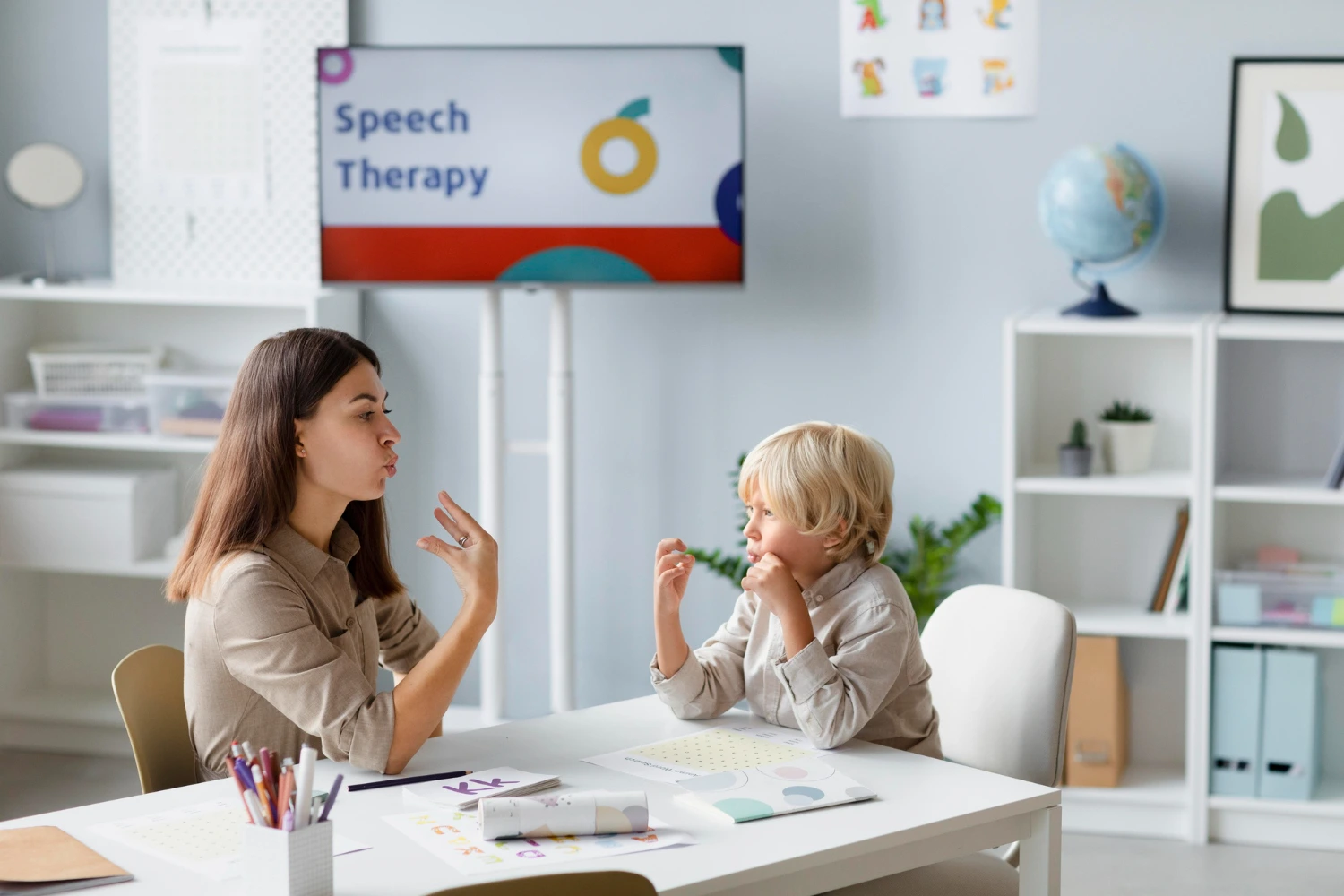
Choose Your Category
Opening Doors to Inclusive Careers: Explore a Spectrum of Job Categories Tailored for Every Special Individual's Potential
Recent Job Listing
From Education to Technology, Healthcare to Creative Arts, Find Meaningful Opportunities.

Every Special Child
Every Special Child (ESC) is a growing organization connecting schools with professionals in the field of education. We are dedicated to delivering excellence with unwavering expectations for each student’s achievement and success. Our team of devoted professionals wholeheartedly ensures the highest quality of services, fostering and upholding strong relationships with schools and professionals.
Each member of our team is thoroughly qualified, certified, and possesses extensive experience, collaborating closely with schools and qualified/certified school professionals.
Our Testimonials
Blogs & News

LVN vs RN: Which Path Is Right for You? Education, Licensing, and Salary Explained
LVN vs RN: Which Path Is Right for You? Education, Licensing, and Salary Explained Which Nursing Path Is Right for You Choosing between becoming a Licensed Vocational Nurse (LVN) or a Registered Nurse (RN) is one of the biggest dilemmas aspiring nurses face. Both roles are vital in healthcare, offering rewarding careers filled with purpose. However, the paths differ in education, responsibilities, pay, and growth potential. Let’s dive deep into what sets them apart and help you find which path aligns best with your goals. Apply Now. Understanding the Basics What Is an LVN? Which Nursing Path Is Right for You An LVN (Licensed Vocational Nurse) provides basic nursing care under the supervision of RNs and physicians. LVNs monitor patient health, assist with daily care, and perform basic medical tasks, such as taking vital signs and administering medications. In some states, LVNs are called LPNs (Licensed Practical Nurses)—same role, different name. Read More Articles. What Is an RN? An RN (registered nurse) has a broader scope of practice. They assess patient needs, create care plans, administer medications, and supervise LVNs or nursing assistants. RNs often take on leadership roles and make critical decisions in patient care. Key Differences The main difference lies in education, responsibility, and autonomy. RNs require more schooling but gain greater career flexibility and higher pay. Educational Requirements LVN Education and Training Becoming an LVN usually requires completing a 1-year vocational program. These programs are available at community colleges and technical schools and include classroom learning plus supervised clinical experience Which Nursing Path Is Right for You. See More RN Education Pathways RNs have two main routes: ADN (Associate Degree in Nursing) – Takes about 2 years. BSN (Bachelor of Science in Nursing)—Takes about 4 years and opens doors to advanced roles. Duration and Cost Comparison LVN: ~1 year, $10,000–$20,000 RN (ADN): ~2 years, $20,000–$40,000 RN (BSN): ~4 years, $40,000–$100,000 While RN programs take longer and cost more, the long-term payoff is usually higher. Licensing and Certification LVN Licensing After completing training, LVN candidates must pass the NCLEX-PN (Practical Nurse Exam) to become licensed. RN Licensing RNs must pass the NCLEX-RN, a more comprehensive exam that tests advanced nursing knowledge and decision-making. Continuing Education Which Nursing Path Is Right for You Both LVNs and RNs must renew their licenses periodically and complete continuing education to stay current with medical practices. Scope of Practice LVN Responsibilities LVNs: Monitor patients’ vital signs Provide basic patient care Administer certain medications Assist with hygiene and comfort RN Responsibilities RNs: Conduct patient assessments Develop care plans Administer complex treatments Supervise other nursing staff RNs hold greater authority and often make independent clinical decisions. Work Settings Where Do LVNs Work? LVNs typically work in: Nursing homes Rehabilitation centers Home healthcare Clinics Where Do RNs Work? RNs are found in: Hospitals Emergency rooms Intensive care units Schools and public health departments RNs also have more opportunities to specialize (e.g., pediatrics, ICU, oncology). Salary Comparison LVN Salary The average LVN salary in the U.S. is around $55,000 per year, varying by state and experience. RN Salary RNs earn significantly more—around $80,000–$100,000 annually. BSN-prepared RNs, or those in high-demand areas, can make six figures. Factors Affecting Pay Location Experience Education level Specialization Career Growth and Advancement LVN Career Growth LVNs can specialize in areas like geriatric care or home health, but advancement opportunities are somewhat limited without further education. RN Career Advancement Which Nursing Path Is Right for You RNs can move into leadership, management, or advanced practice roles (like Nurse Practitioner). They can also pursue MSN or DNP degrees for even higher-level positions. Job Outlook Which Nursing Path Is Right for You LVNs and RNs is rising due to an aging population and healthcare expansion. However, RNs have a faster growth rate and broader job options. Work-Life Balance LVNs often enjoy more predictable schedules, especially in long-term care settings. RNs, particularly in hospitals, may face rotating shifts but have greater career mobility and options for part-time or travel nursing. Ideal Skills and Personality Fit Ideal for LVNs Compassionate and patient Enjoy hands-on caregiving Prefer quicker entry into nursing Ideal for RNs Strong critical thinking Leadership and communication skills Comfortable with responsibility and decision-making Perks of Being an LVN Faster start to your nursing career Lower tuition costs Flexible transition to higher nursing roles later Perks of Being an RN Higher earning potential More autonomy Greater career variety and advancement Upgrade From LVN to RN With Bridge Programs These programs allow LVNs to become RNs in 12–18 months, leveraging existing experience. Bridge programs are cost-effective and offer flexibility (many are online or hybrid) Which Nursing Path Is Right for You. FAQs How quickly can one become a registered nurse? Enroll in an accelerated ADN or BSN program or take an LVN-to-RN bridge course. Can LVNs work in hospitals? Yes, but opportunities may be limited compared to RNs. Is the LVN license worth it? Absolutely! It’s a great starting point for those eager to join the healthcare field quickly. How long does it take to go from LVN to RN? Typically 12–18 months, depending on the bridge program and schedule. Do RNs make significantly more than LVNs? Yes. RNs often earn $25,000–$40,000 more per year, depending on specialization and location.
Published on Dec 11, 2025

Top LVN Programs in California: What You Need to Know
Top LVN Programs in California: What You Need to Know LVN Programs in California If you’ve been thinking about a career in healthcare but don’t want to spend years in nursing school, becoming a Licensed Vocational Nurse (LVN) might be your perfect path. California offers some of the most reputable LVN programs in the U.S., providing hands-on training and career-ready education to help you launch your nursing career fast. Apply Now. What is an LVN? An LVN (Licensed Vocational Nurse) is a healthcare professional who provides basic nursing care under the supervision of registered nurses (RNs) and doctors. LVNs work in hospitals, clinics, long-term care facilities, and home healthcare settings. LVN vs. RN: What’s the Difference? While both LVNs and RNs are vital in patient care, RNs have broader responsibilities, more education, and higher pay. However, LVN programs are shorter and more affordable, making them a great entry point into nursing. Read More Articles. Why Choose an LVN Career in California LVN Programs in California consistently ranks among the top states for LVN employment and pay. With a median annual salary of around $65,000, LVN Programs in California earn significantly more than the national average. Benefits of Becoming an LVN Short training duration (12–18 months) High job security Opportunities to advance to RN through bridge programs Meaningful, patient-centered work Eligibility Requirements for LVN Programs Before applying, ensure you meet these basic requirements: High school diploma or GED Minimum GPA (varies by school) Background check and immunization record Passing score on an entrance exam (like TEAS or Wonderlic) Top Accredited LVN Programs in California Why Accreditation Matters Always choose a school accredited by the California Board of Vocational Nursing and Psychiatric Technicians (BVNPT). Accreditation ensures your training meets state standards and qualifies you for the NCLEX-PN exam. California Career College Located in Canoga Park, this college offers a comprehensive LVN program combining classroom learning and clinical rotations. Program Length: 14 months Tuition: Approximately $30,000 Highlights: Flexible scheduling, modern labs, and strong job placement rates. Unitek College Unitek College is one of California’s most popular LVN schools, with campuses across the state. Program Duration: 12 months Features: Simulation labs, NCLEX-PN prep, and financial aid options. Why Choose It: Unitek has a strong reputation for helping students land jobs right after graduation. Gurnick Academy of Medical Arts This academy offers a structured and flexible LVN program ideal for working students. Program Length: 13 months Clinical Sites: Partnered with top healthcare facilities. Perks: Career services, scholarships, and hybrid learning options. Pasadena City College As one of California’s top public colleges, PCC offers a cost-effective LVN program. Tuition: Around $6,000 (in-state) Program Duration: 18 months Why Choose It: Excellent faculty support and strong local hospital connections. American Career College Known for its accelerated LVN program, ACC prepares students for real-world healthcare settings quickly. Program Length: 13 months Highlights: Job placement assistance, flexible schedules, and top-tier NCLEX pass rates. Online and Hybrid LVN Programs in California Many schools now offer online or hybrid LVN options, where students complete theoretical coursework online and attend labs or clinical rotations in person. Pros: Flexibility, self-paced learning. Cons: Limited hands-on exposure compared to traditional programs. Cost of LVN Programs in California LVN tuition in California typically ranges between $10,000 and $35,000, depending on the school. Financial Aid: Federal Pell Grants California College Promise Grant School-specific scholarships LVN Licensing Exam (NCLEX-PN) LVN Programs in California After completing your program, you must pass the NCLEX-PN exam to obtain your license. Tips to Succeed: Take plenty of practice tests Join study groups Use NCLEX prep apps Stay consistent with daily review sessions Job Outlook for LVNs in California According to the Bureau of Labor Statistics, LVN employment in California is expected to grow 6% by 2032. Major employers include hospitals, nursing homes, rehabilitation centers, and private clinics. See More Top Cities for LVN Jobs Los Angeles San Diego San Jose Sacramento FAQs How long does it take to complete an LVN program in California? Most LVN programs take 12 to 18 months, depending on the school and whether you study full-time or part-time. Is becoming an LVN worth it in California? Yes! LVNs in California enjoy some of the highest salaries and strong job stability compared to other states. Can I study to be an LVN online in California? Yes, many schools offer hybrid LVN programs, combining online coursework with on-site clinical training. What’s the difference between LVN and CNA? LVNs have more responsibilities and higher pay and must pass a licensing exam, while CNAs provide basic care under supervision. How can I become an RN after becoming an LVN? You can enroll in LVN-to-RN bridge programs, which let you build on your existing skills and earn an RN license faster.
Published on Dec 10, 2025

How to Become a Licensed Vocational Nurse: Step-by-Step Guide
How to Become a Licensed Vocational Nurse: Step-by-Step Guide Become a Licensed Vocational Nurse. Dreaming of a career where you can make a real difference every day? Your ideal career path might be to become a Licensed Vocational Nurse (LVN).. LVNs are the backbone of patient care—providing comfort, administering medication, and supporting both patients and medical teams. Apply Now. In this guide, we’ll walk you through each step to becoming an LVN, from education to certification, so you can start your nursing journey with confidence. Understanding the Role of a Licensed Vocational Nurse What Does an LVN Do? Become a Licensed Vocational Nurse provide essential nursing care under the supervision of doctors and registered nurses. Their daily tasks include: Monitoring patients’ vital signs Administering medication Assisting with personal hygiene Recording patient information Where Do LVNs Work? LVNs work in various healthcare environments, such as: Hospitals Nursing homes Rehabilitation centers Private clinics Home health care settings LVN vs RN: What’s the Difference? While both LVNs and RNs provide patient care, RNs have more advanced training and responsibilities. The LVN role is perfect for those seeking a quicker entry into nursing with opportunities to advance later. Read More Articles. Step-by-Step Guide to Become a Licensed Vocational Nurse Step 1 – Complete High School or GED Before you can apply for an LVN program, you’ll need a high school diploma or GED. Anatomy, chemistry, and biology classes can provide you with a solid foundation. Step 2 – Enroll in an Approved LVN Program Find a state-approved LVN training program, typically offered at community colleges, vocational schools, or technical institutes. Duration: Usually 12–18 months Curriculum Includes: Anatomy & physiology Nursing fundamentals Pharmacology Clinical practice Hands-on training is crucial, helping you apply classroom learning in real healthcare settings. Step 3 – Gain Hands-On Experience During your training, you’ll complete clinical rotations in hospitals or care centers. This experience helps you: Build confidence in patient care Understand teamwork in healthcare Develop problem-solving and observation skills Step 4 – Apply for Licensure Once you’ve completed your program, the next step is applying to your state board of nursing for permission to take the licensing exam. You’ll need to submit: Transcripts Proof of training Identification documents Application fees Step 5 – Pass the NCLEX-PN Exam The National Council Licensure Examination for Practical Nurses (NCLEX-PN) is a must for becoming an LVN. What’s on the Exam: Safety and infection control Health promotion and maintenance Psychosocial integrity Pharmacological therapies Study Tips: Use NCLEX practice tests Study a little every day Join online study groups Passing the NCLEX-PN officially qualifies you for licensure. Step 6 – Obtain State Licensure Become a Licensed Vocational Nurse After passing your exam, you’ll receive your state-issued LVN license. Keep track of renewal requirements to stay active in your nursing career. Step 7 – Start Working as an LVN Become a Licensed Vocational Nurse With your license in hand, you can start working in hospitals, clinics, nursing homes, or home health agencies. Entry-level positions offer invaluable experience to grow your nursing skills. Continuous learning is key—professionals must stay updated on inclusive teaching strategies, assistive technologies, and behavioral intervention techniques. See More Educational Pathways and Specializations Bridge Programs for LVNs If you want to advance your career, consider LVN-to-RN bridge programs. These allow LVNs to become Registered Nurses in as little as 1–2 years while working part-time. Specialized Areas for LVNs LVNs can specialize in: Pediatrics – caring for children Geriatrics—supporting elderly patients Mental health—assisting patients with emotional or psychological needs Salary and Job Outlook According to the U.S. Bureau of Labor Statistics, the average salary for LVNs is around $50,000–$60,000 per year, depending on location and experience. Top-paying states include: California Texas Massachusetts Washington The demand for LVNs continues to grow as the population ages, ensuring a stable and rewarding career path. Skills Every LVN Should Have Empathy: Understanding patient emotions builds trust. Communication: Clear interactions ensure accurate care. Technical skills: Administering injections and using medical equipment efficiently. Organization: Managing multiple patients effectively. Challenges and Rewards of Being an LVN Being an LVN isn’t always easy—long shifts, emotional moments, and physical demands can be challenging. But the rewards? Seeing patients recover, forming meaningful connections, and knowing you make a difference daily. Continuing Education and License Renewal To keep your license active, most states require continuing education (CE) hours. These may include workshops, online courses, or advanced certifications—helping you stay updated with new healthcare practices. FAQs How long does it take to become an LVN? It usually takes 12 to 18 months to complete an LVN program and earn your license. Is the LVN exam difficult? It’s challenging but manageable with proper preparation and consistent study habits. Can LVNs work in hospitals? Yes, LVNs are employed in hospitals, nursing homes, clinics, and home healthcare agencies. What are the best states for LVN jobs? California, Texas, and Florida have the highest demand for LVNs with competitive pay. Can LVNs specialize in certain areas? Absolutely! LVNs can specialize in pediatrics, geriatrics, rehabilitation, or mental health.
Published on Dec 10, 2025

























